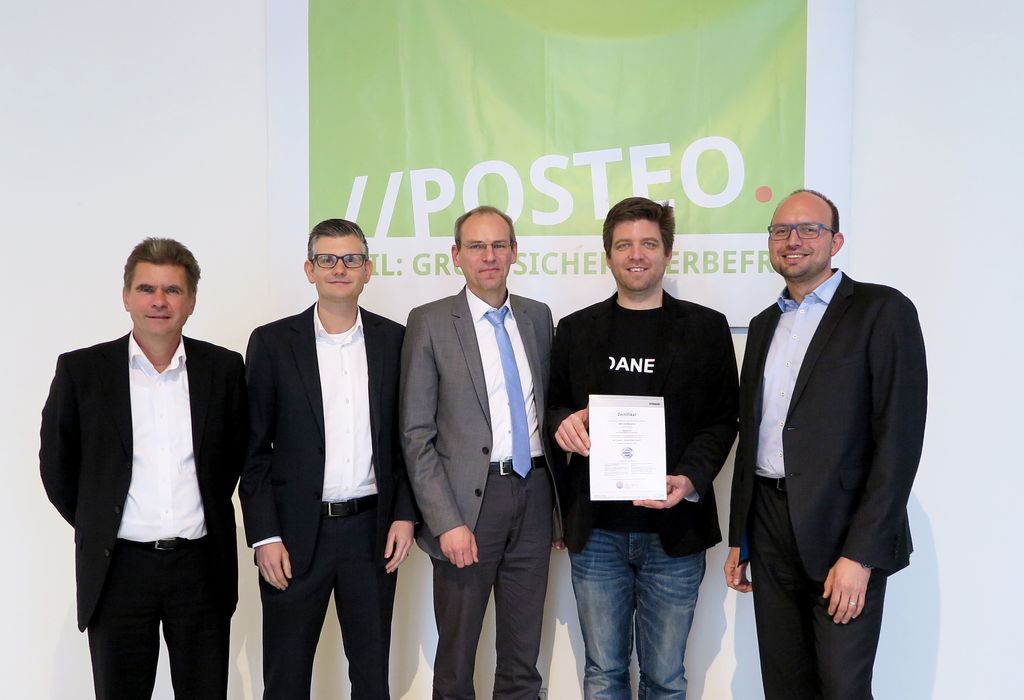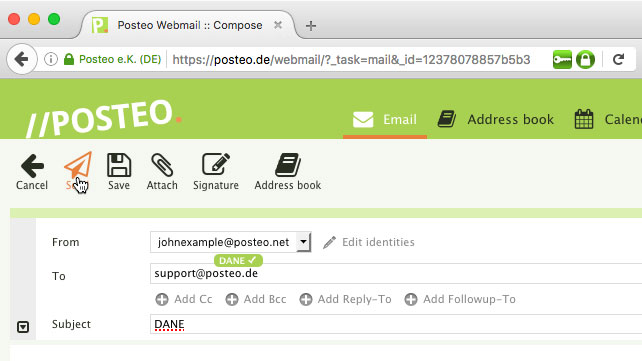Posteo becomes the first provider to receive a certificate for secure sending of emails
Created on 08. December 2016, 18:40 | Category: Info
Dear Posteo users and interested parties,
At Posteo it is especially important to us that you can securely send and receive emails. Today there is news on this front: We have become the first provider to receive a certificate for the new “secure email transport” technical guidelines by the Federal Office for Information Security (Bundesamt für Sicherheit in der Informationstechnik, henceforth BSI). The goal of the BSI is to promote IT security.
The certificate was today awarded to us by the certifying authority “datenschutz cert”. Representatives of the BSI were also present. Via the certificate on our website, you can now identify that our security measures have been independently checked and proven to conform to BSI requirements.

Thomas Gast (BSI), Thomas Gilles (BSI), Ralf von Rahden (datenschutz cert), Patrik Löhr (Posteo), Florian Bierhoff (BSI)
The new technical guidelines detail the measures that an email service is to undertake in order to actively protect emails from unauthorised third parties during their transport. Email providers need to implement DANE if they wish to receive certification. DANE overcomes various weaknesses in the commonly-used transport route encryption, TLS. Among other things, DANE prevents so-called man-in-the-middle attacks, in which an attacker latches onto a communication process, annulling the encryption. In 2014, Posteo became the first provider to implement DANE. Since then we have committed ourselves to the dissemination of this new technology, which is pioneering in the confidentiality of digital communication. Thus our users can not only securely communicate with one another, but also with the users of other email services. We were therefore especially pleased that the free standard DANE has become necessary for the certification.
Since 2014 we have been engaged in a working group together with other email providers involved in a dialogue with the BSI that led to the formation of the technical guidelines. We pushed for high security requirements and simple implementation.
We frequently criticise authorities when things don’t work in practice, for example, in our transparency reports. On the other hand, we welcome the BSI’s new guidelines for secure email transport. The BSI was especially interested in working together with the providers to design the guidelines with a practical orientation. The guidelines correlate with the highest security requirements and the certification is also implementable in terms of the time and money involved for smaller providers such as Posteo.
New certificate identifies secure email services
In our view, the fact that claims made by email providers about their security measures can now be evaluated by independent authorities also constitutes great progress for users. From now on, users can identify whether a service has been proven to fulfil the criteria in the guidelines via the certificates on the providers’ websites. The logo with text “BSI TR-03108 zertifiziert” indicates the corresponding guidelines.
The BSI guidelines do not constitute a legal requirement, but rather recommend security measures to email providers. Providers that wish to receive a corresponding certificate need to prove that they fulfil all requirements set out.
Certification is undertaken by an independent body – Posteo was certified by datenschutz cert. Certification occurs entirely remotely, checking the email service’s public interfaces. Other email providers and services such as those of companies or universities, for example, can now register to be evaluated according to the technical guidelines. We hope that the guidelines further increase dissemination of the recommended security technology. High common standards also increase the level of security for emails that you send to contacts that use other email providers. Thus communication becomes more secure overall.
Best regards,
The Posteo team
Additional information for those with technical interests:
- The technical guidelines can be found on the BSI website,
- Posteo has used DANE since May 2014. You can read more about DANE here.
- End-to-end encryption does not render transport route encryption redundant. End-to-end encryption generally only protects the content of your communication, but not metadata such as the subject field and information as to who is communicating with whom. Transport route encryption with TLS protects the content as well as the metadata for emails on their way across the internet. DANE additionally secures this encryption. End-to-end encryption is always in the hands of the users, because no-one else can have access to the private keys. We recommend combining end-to-end encryption with strong transport route encryption on the provider’s side.



